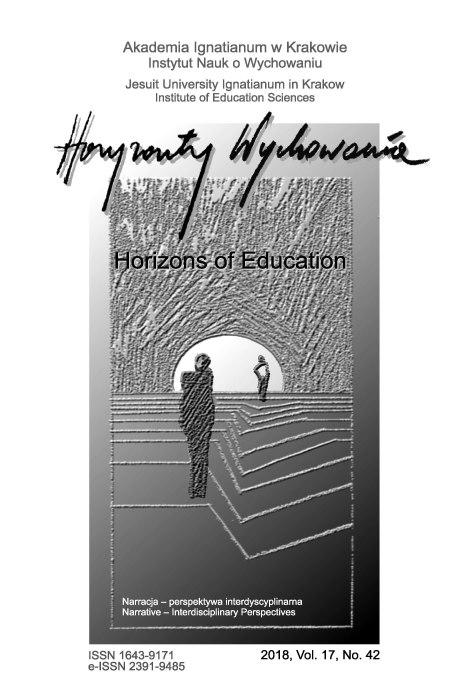Cele i strategie wspierania rozwoju narracyjnego dzieci
Abstrakt
CEL NAUKOWY: Celem artykułu jest przedstawienie, na przykładzie istniejących programów interwencyjnych, znaczenia dla dobrostanu dziecka wielowymiarowej profilaktyki trudności wynikających z deficytów w zakresie rozwoju kompetencji narracyjnej.
PROBLEMY I METODY BADAWCZE: Problem badawczy sformułowano następująco: Jakie są cele i strategie wspierania rozwoju kompetencji narracyjnej? Wykorzystana została metoda analizy i syntezy literatury.
PROCES WYWODU: W artykule pokazana została istota i konsekwencje zaburzeń w rozwoju kompetencji narracyjnej. Wskazano i opisano poszczególne elementy procesu profilaktycznego: scharakteryzowani zostali jego uczestnicy, obszary kompetencji narracyjnej polegające działaniom profilaktycznym oraz skuteczność tych oddziaływań wraz z jej uwarunkowaniami.
WYNIKI ANALIZY NAUKOWEJ: Prawidłowy rozwój w sferze kompetencji narracyjnej jest istotnym czynnikiem warunkującym dobrostan dziecka. Istnieje szereg możliwości wspierania rozwoju w różnych jego obszarach. Czynnikami warunkującymi skuteczność interwencji narracyjnych są: czas trwania, zaangażowanie i kontekst, zaś środowiskiem szczególnie predysponowanym do wspierania rozwoju dzieci jest rodzina.
WNIOSKI, INNOWACJE, REKOMENDACJE: Z dokonanych analiz wynika, że wzrasta społeczna świadomość znaczenia prawidłowego rozwoju w zakresie kompetencji narracyjnej, niemniej jednak istnieje jeszcze niezagospodarowana przestrzeń związana z edukacją nauczycieli i rodziców na temat możliwośći działań interwencyjnych.
Bibliografia
Baumer, S., Ferholt, B., Lecusay R. (2005). Promoting narrative competence through adult–child joint pretense: Lessons from the Scandinavian educational practice of playworld. Cognitive Development, 20, 576–590.
Bishop, D. V. M., Edmundson, A. (1987). Language impaired 4-year-olds: Distinguishing transient from persistent impairment. Journal of Speech and Hearing Disorders, 52, 156–173.
Boland, A.M., Haden, C.A., Ornstein, P.A. (2003). Boosting Children’s Memory by Training Mothers in the Use of an Elaborative Conversational Style as an Event Unfolds, Journal of Cognition and Development, 4(1), 39–65.
Fivush, R. (2007). Maternal Reminiscing Style and Children’s Developing Understanding of Self and Emotion, Clinical Social Work Journal, 35, 37–46.
Gaś, Z. (1998). Psychoprofilaktyka. Procedury konstruowania programów wczesnej interwencji. Lublin: Wydawnictwo UMCS.
Gillam, R., McFadden, T. U., van Kleek, A. (1995). Improving the narrative abilities of children with language disorders: Whole language and language skills approaches. W: M. Fey, J. Windsor, J. Reichle (red.) Communication intervention for school-age children (145–182). Baltimore, MD: Paul H. Brookes.
Hakkarainen, P. (2004). Narrative learning in the fifth dimension. Outlines: Critical Social Studies, 6 (1), 5–20.
Hayward, D., Schneider, P. (2000). Effectiveness of teaching story grammar knowledge to pre-school children with language impairment. An exploratory study, Child Language Teaching and Therapy, 16(3), 254-284.
Labov, W., Waletzky, J. (1967). Narrative analysis: oral versions of personal experience. W: J. Helm, (red.), Essays on the verbal and visual arts (12-44). Seattle: Washington University Press.
Mandler, J.M., Johnson, N.S. (1977) Remembrance of things parsed: Story structure and recall. Cognitive Psychology, 9, 111-151.
McCabe, A., Bliss, L., Barra, G., Bennett, M. (2008) Comparison of Personal Versus Fictional Narratives of Children With Language Impairment. American Journal of Speech-Language Pathology, 17, 194–206.
McCabe, A., Rollins, P.R. (1994). Assessment of Preschool Narrative Skills. American Journal of Speech-Language Pathology, 3(1), 45-56.
Nadolska, H. (1995). Kompetencja narracyjna uczniów o różnym poziomie intelektualnym. Przejawy,uwarunkowania, tendencje rozwojowe. Białystok: Erbe.
Petersen, D.B., (2010). A Systematic Review of Narrative-Based Language Intervention With Children Who Have Language Impairment. Communication Disorders Quarterly, XX(X), 1–14.
Petersen, D.B., Spencer, T.D. (2016). Using Narrative Intervention to Accelerate Canonical Story Grammar and Complex Language Growth in Culturally Diverse Preschoolers, Topics in Language Disorders, 36(1), 6–19.
Rozporządzeniem Ministra Edukacji Narodowej z dnia 14 lutego 2017 r. w sprawie podstawy programowej wychowania przedszkolnego oraz podstawy programowej kształcenia ogólnego dla szkoły podstawowej (Dz. U. z 2017 r., poz. 356)
Rumelhart, D. (1975). Notes on a schema of stories. W: D. Bobrow, A. Collins, (red.) Representation and understanding (237-272). New York: Academic Press.
Scarborough, H. S. (2001). Connecting early language and literacy to later reading (dis)abilities: Evidence, theory, and practice. W: S. B. Neuman, D. K. Dickinson (red.), Handbook of early literacy research ( 97–110). New York: Guilford
Smoczyńska, M., Haman, E., Kochańska, M., Łuniewska, M. (2015). Standaryzowane Narzędzia do Oceny Wypowiedzi SNOW. Warszawa: Instytut Badań Edukacyjnych.
Soroko, E., Wojciechowska , J. (2015). Kompetencja narracyjna jako obszar nauczania i oceny w edukacji, Studia Edukacyjne, 37, 211-236.
Stein, N.L., Glenn, C.G. (1979) An analysis of story comprehension in elementary school children. W: R. Freedle (red.), New directions in discourse processing (Vol. 2) (53-120). Norwood, NJ: Ablex.
Uchwała Nr 180/2015 Rady Ministrów z dnia 6 października 2015 r.
Westby, C. (1985). Learning to talk, talking to learn: Oral literate language differences. W: C.S. Simon, (red.) Communication skills and classroom success: Therapy methodologies for language learning disabled students (s. 182 -213). San Diego: College Hill.
Copyright (c) 2018 Irmina Rostek

Utwór dostępny jest na licencji Creative Commons Uznanie autorstwa – Bez utworów zależnych 4.0 Międzynarodowe.
Uwagi dotyczące praw autorskich
Autorzy publikujący w tym czasopiśmie wyrażają zgodę na następując warunki:
- Autorzy zachowują prawa autorskie, przyznając czasopismu prawo do pierwszej publikacji swojego tekstu jednocześnie zarejestrowanego pod numerem licencji CC BY-ND, która pozwala innym na korzystanie z tego tekstu z uznaniem autorstwa tekstu oraz pierwotnej publikacji w tym czasopiśmie.
- Autorzy proszeni są o nawiązywanie odrębnych, dodatkowych porozumień wynikających z umowy, dotyczących dystrybucji opublikowanej w czasopiśmie wersji tekstu nie na prawach wyłączności (np. opublikowanie go w repozytorium instytucji lub w innym czasopiśmie), z potwierdzeniem pierwszej publikacji w tym czasopiśmie.
Wyraża się zgodę i zachęca autorów do publikacji ich tekstu w Internecie (np. w repozytorium instytucji lub na jej stronie internetowej) przed lub podczas procesu składania tekstu jako, że może to prowadzić do korzystnych wymian oraz wcześniejszego i większego cytowania opublikowanego tekstu (Patrz The Effect of Open Access). Zalecamy wykorzystanie dowolnego portalu stowarzyszeń badawczych z niżej wymienionych:





